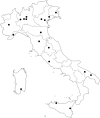A survey of clinical practice concerning long-term follow-up of neurogenic lower urinary tract dysfunction due to spinal cord injury in Italy
- PMID: 33848215
- PMCID: PMC9662064
- DOI: 10.1080/10790268.2020.1863899
A survey of clinical practice concerning long-term follow-up of neurogenic lower urinary tract dysfunction due to spinal cord injury in Italy
Abstract
Context/objective: This study aimed to assess the clinical practice for long-term follow-up (FU) of neurogenic lower urinary tract dysfunction (NLUTD) due to spinal cord injury (SCI) in Italy and compare this practice with the clinical practice in other countries and with the international guidelines.
Design: Data concerning the long-term urological FU of individuals with SCI were collected using a questionnaire and analyzed by means of descriptive and inferential statistics.
Setting: Twenty-one Italian centers following SCI patients.
Participants: One physician at each center (either a permanent staff member or chief).
Outcome measures: Questions addressed the treatment of urinary tract infections (UTI), frequency of visits, urinary tract imaging examinations and urodynamic tests (UD), distinguishing between suprasacral and sacral SCI.
Results: Nineteen out of 21 centers completed the survey. In most centers, patients were recommended to undergo a visit and an ultrasound examination of urinary tract (UT) at least once a year. While the median interval between FU visits was identical (12 months) for individuals with suprasacral and sacral SCI, the two interval distributions were significantly different (suprasacral SCI: min-max 4-18, IQR = 6; sacral SCI: min-max 6-24; IQR = 8.5; P = 0.02), showing people with suprasacral SCI are followed up more often. Approximately 80% of the surveyed centers performed scheduled UD, with a yearly median frequency of 12 months (range 6-36) for patients with suprasacral SCI, as compared to a median frequency of 18 months for sacral SCI (range 0-36, P = 0.04). VideoUD and antibiotic prophylaxis for recurrent UTIs are carried out only by urologists in 63% and 47.4% of the centers, respectively. Overall, Italian centers share common strategies that compare to standards, including yearly visits, yearly UT examinations and stricter follow-up of people with suprasacral SCI, but may not have standard protocols for antibiotic prophylaxis of UTI, and in few cases control visits and UD are carried out too often.
Conclusions: Even though most Italian centers follow up patients with NLUTD secondary to SCI according to international guidelines, heterogeneity in frequency of FU examinations still exists. A tailored approach to the SCI patient that minimizes unnecessary examinations and groups different tests in a single access could improve patients' compliance with FU and reduce costs for the Health system.
Keywords: Clinical practice; Neurogenic lower urinary tract dysfunction; Spinal cord injury; Survey; Urological follow-up.
Figures
References
-
- Gousse A, Meinbach D, Kester R, Razdan S, Kim S, Pareek K, et al. . Renal ultrasound correlates with renal nuclear scan in upper tract surveillance of spinal cord-injured patients. Top Spinal Cord Inj Rehabil. 2003;8(3):1–7. doi:10.1310/P5JU-E4HD-ER10-HKQ9. - DOI
MeSH terms
LinkOut - more resources
Full Text Sources
Other Literature Sources
Medical

